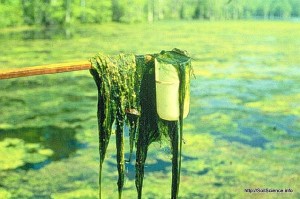
Whether in a farm pond like this, or the Gulf of Mexico, algae blooms stimulated by wasted fertilizer are deadly to marine life. Fortunately, or unfortunately, we're running out of fertilizer.
Here’s the bottom line, obvious to all but the most arithmetically challenged: when you base an entire civilization on the rapid consumption of a limited resource, you guarantee the collapse of that civilization on the day the resource is exhausted. But the ride to that final day is not a smooth one; you also guarantee that chaos will ensue from the time that there is not enough left of the depleted resource to meet all demands. Running completely out of water is a shared disaster, but when there’s enough water for some but not all, choosing the “some” gets ugly, real fast. It has gradually dawned on a growing number of people that this is the bottom line for oil, but it is not yet widely accepted that the same bottom line, with the same potential for destruction, exists for a number of other substances, especially phosphorous.
Like oil, phosphorous is essential to industrial agriculture. (Unlike oil, phosphorous is essential to life itself, but that’s in trace amounts that are usually provided in nature.) The vast quantities required for the manufacture of synthetic fertilizer are available only from deposits of phosphate rock. There are some in the United States, but two-thirds of the phosphate rock known to exist in the world are in China and North Africa. Uh-oh. Demand for phosphorous is enormous and growing, by 800 per cent in just two years, 2006-08. Uh-oh. And a new study published yesterday warns that we are about to experience what happens when the demand exceeds the supply.
The industrial-scale irony here is that 80 per cent of the phosphorous that is mined to grow food is wasted. Most of the waste occurs in the mis-application, or over-application, of the fertilizer, which inflicts on the world one of its worst and most destructive forms of water pollution. Along with the nitrogen in the wasted fertilizer, which washes off the land into the water, the phosphorous stimulates excessive growth of algae in streams, lakes and oceans. The mats of algae (some of which are toxic) first block sunlight needed by other plants, then when they decay extract from the water the oxygen needed by all living things. The resulting dead zone (where nothing, repeat nothing, lives) created by this process at the mouth of the Mississippi River, for example, is the size of New Jersey. A study by Kansas State University two years ago estimated the cost of this problem, to the US alone, at $4.3 billion a year.
This pollution is caused almost exclusively by rich, industrial growers. Poor farmers who have been taught to use industrial chemicals to grow food can no longer afford fertilizer — its price has gone up at about the same rate as the demand. On the other hand, poor and subsistence farmers who practice sustainable agriculture (either because that is their tradition, they don’t know any better, or because they have wised up) have no need for synthetic fertilizer.
Like every other industrial process, the phosphorous industry, in seeking ever larger economies of scale in extracting phosphate rock, processing it and marketing it as synthetic fertilizer, has concentrated risk. But the risk, which is now approaching global and catastrophic levels, has been deferred while the industrialists extracted their profits. Moreover, the penalties imposed by the risks will be almost entirely borne by people who had no share in the profits.
And that’s the bottom line.
I wonder why this farmer dosen’t airate and pump that water algae and all back on his fields? recap the fertillizer and get biomass for building better soil.